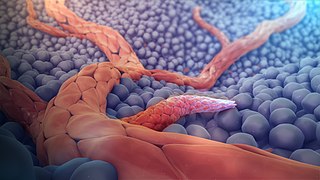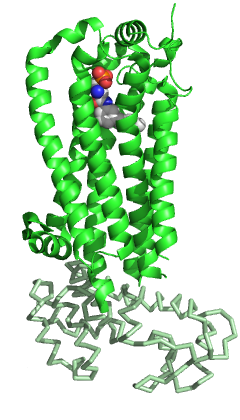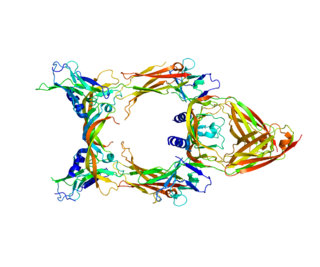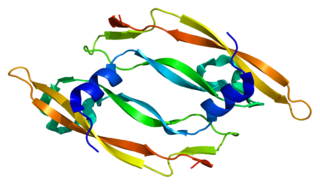Vascular endothelial growth factor A (VEGF-A) is a protein that in humans is encoded by the VEGFA gene. [5]
Vascular endothelial growth factor A (VEGF-A) is a protein that in humans is encoded by the VEGFA gene. [5]
This gene is a member of the platelet-derived growth factor (PDGF)/vascular endothelial growth factor (VEGF) family and encodes a protein that is often found as a disulfide linked homodimer. This protein is a glycosylated mitogen that specifically acts on endothelial cells and has various effects, including mediating increased vascular permeability, inducing angiogenesis, vasculogenesis, and endothelial cell growth, promoting cell migration, and inhibiting apoptosis. Alternatively, spliced transcript variants, encoding either freely secreted or cell-associated isoforms, have been characterized. [6]
VEGF-A shows prominent activity with vascular endothelial cells, primarily through its interactions with the VEGFR1 and -R2 receptors found prominently on the endothelial cell membrane. However, it does have effects on a number of other cell types (e.g., stimulation monocyte/macrophage migration, neurons, cancer cells, kidney and epithelial cells ). In vitro, VEGF-A has been shown to stimulate endothelial cell mitogenesis and cell migration. VEGF-A is also a vasodilator and increases microvascular permeability and was originally referred to as vascular permeability factor.
During embryonic development angiogenesis is initiated as mesoderm mesenchyme cells are specified to differentiate into angioblasts, expressing the Vascular Endothelial Growth Factor Receptor (VEGFR-2). As embryonic tissue utilizes more oxygen than it receives from diffusion, it becomes hypoxic. These cells will secrete the signaling molecule vascular endothelial factor A (VEGFA) which will recruit the angioblasts expressing its partnering receptor to the site of future angiogenesis. The angioblasts will create scaffolding structures that form the primary capillary plexus from where the local vasculature system will develop. Disruption of this gene in mice resulted in abnormal embryonic blood vessel formation, resulting in underdeveloped vascular structures. This gene is also upregulated in many tumors and its expression is correlated with tumor development and is a target in many developing cancer therapeutics. Elevated levels of this protein are found in patients with POEMS syndrome, also known as Crow-Fukase syndrome which is a hemangioblastic proliferative disorder. Allelic variants of this gene have been associated with microvascular complications of diabetes 1 and atherosclerosis.
Vascular endothelial growth factor A (VEGF-A) is a dimeric glycoprotein that plays a significant role in neurons and is considered to be the main, dominant inducer of the growth of blood vessels. VEGFA is essential for adults during organ remodeling and diseases that involve blood vessels, for example, in wound healing, tumor angiogenesis, diabetic retinopathy, and age-related macular degeneration. During early vertebrate development, vasculogenesis occurs which means that the endothelial condense into the blood vessels. The differentiation of endothelial cells is dependent upon the expression of VEGFA and if the expression is abolished then it can result in the death of the embryo. VEGFA is produced by a group of three major isoforms as a result of alternative splicing and if any three isoforms are produced (VEGFA120, VEGFA164, and VEGFA188) then this will not result in vessel defects and death of the full VEGFA knockout in mice. VEGFA is essential in the role of neurons because they too need vascular supply and abolishing the expression of VEGFA from neural progenitors will result in defects of the brain vascularization and neuronal apoptosis. Anti-VEGFA therapy can be used to treat patients with undesirable angiogenesis and vascular leakage in cancer and eye diseases but also could result in the inhibition of neurogenesis and neuroprotection. VEGFA could be used to treat patients with neurodegenerative and neuropathic conditions and also increase vascular permeability which will stop the blood-brain barrier and increase inflammatory cell infiltration. [7] [8] [9]
Also tumour suppression. [10]
Elevated levels of this protein is linked to POEMS syndrome, also known as Crow-Fukase syndrome. [11] Mutations in this gene have been associated with proliferative and nonproliferative diabetic retinopathy. [12]
In ischemic cardiomyopathy, blood flow to the muscle cells of the heart is either partially or completely reduced, leading to cell death and scar tissue formation. Because the muscle cells are replaced with fibrous tissue, the heart loses its ability to contract, compromising heart function. [13] Normally, if blood flow to the heart is compromised, over time, new blood vessels will develop, providing alternative circulation to the affected cells. The viability of the heart following severely restricted blood flow is dependent on the ability of the heart to provide this collateral circulation. [14] Expression of VEGF-A has been found to be induced by myocardial ischemia and a higher level of expression of VEGF-A has been associated with better collateral circulation development during ischemia. [15] [16]
When cells are deprived of oxygen, they increase their production of VEGF-A. VEGF-A mediates the growth of new blood vessels from pre-existing vessels (angiogenesis) by binding to the cell surface receptors VEGFR1 and VEGFR2, two tyrosine kinases located in endothelial cells of the cardiovascular system. These two receptors act through different pathways to contribute to endothelial cell proliferation and migration, and formation of tubular structures. [17]
The binding of VEGF-A to VEGFR2 causes two VEGFR2 molecules to combine to form a dimer. Following this dimerization, through the action of the receptor itself, a phosphate group is added to certain tyrosines within the molecule in a process called auto-phosphorylation. [18] The autophosphorylation of these amino acids allows for signalling molecules within to the cell to bind to the receptor and become activated. These signalling molecules include VEGF-receptor activated protein (VRAP), PLC- γ and Nck. [19] [20] [21]
Each of these is important in the signalling required for angiogenesis. VRAP (also known as T-cell specific adaptor) and Nck signalling are important in reorganization of the structural components of the cell, allowing for cells to move around to areas where they are needed. [21] [22] PLC- γ is vital to the proliferative effects of VEGF-A signalling. Activation of the phospholipase PLC- γ results in an increase in calcium levels in the cell, leading to the activation of protein kinase C (PKC). [23] PKC phosphorylates the mitogen-activated protein kinase (MAPK) ERK which then moves to the nucleus of the cell and takes part in nuclear signalling. [24] Once in the nucleus, ERK activates various transcription factors which initiate expression of genes involved in cellular proliferation. [25] Activation of a different MAPK (p38 MAPK) by VEGFR2 is important in the transcription of genes associated with cellular migration. [26]
The tyrosine kinase activity of VEGFR1 is less efficient than that of VEGFR2 and its activation alone is insufficient to bring about the proliferative effects of VEGF-A. [27] The major role of VEGFR1 is to recruit the cells responsible in blood cell development. [28]
It has been shown that injection of VEGF-A in dogs following severely restricted blood flow to the heart caused an increase in collateral blood vessel formation compared to the dogs who did not receive the VEGF-A treatment. [16] It was also shown in dogs that delivery of VEGF-A to areas of the heart with little or no blood flow enhanced collateral blood vessel formation and increased the viability of the cells in that area. [29] In gene therapy, DNA which encodes the gene of interest is integrated into a vector along with elements that are able to promote the gene's expression. The vector is then injected either into muscle cells of the heart or the blood vessels supplying the heart. The natural machinery of the cell is then used to express these genes. [30] Currently, human clinical trials are being conducted to study the effectiveness of gene therapy with VEGF-A in restoring blood flow and function to areas of the heart that have severely restricted blood flow. [31] [32] [33] So far, this type of therapy has proven both safe and beneficial. [33] [34]
Vascular endothelial growth factor A has been shown to interact with:

Angiogenesis is the physiological process through which new blood vessels form from pre-existing vessels, formed in the earlier stage of vasculogenesis. Angiogenesis continues the growth of the vasculature mainly by processes of sprouting and splitting, but processes such as coalescent angiogenesis, vessel elongation and vessel cooption also play a role. Vasculogenesis is the embryonic formation of endothelial cells from mesoderm cell precursors, and from neovascularization, although discussions are not always precise. The first vessels in the developing embryo form through vasculogenesis, after which angiogenesis is responsible for most, if not all, blood vessel growth during development and in disease.

The endothelium is a single layer of squamous endothelial cells that line the interior surface of blood vessels and lymphatic vessels. The endothelium forms an interface between circulating blood or lymph in the lumen and the rest of the vessel wall. Endothelial cells form the barrier between vessels and tissue and control the flow of substances and fluid into and out of a tissue.

Platelet-derived growth factor (PDGF) is one among numerous growth factors that regulate cell growth and division. In particular, PDGF plays a significant role in blood vessel formation, the growth of blood vessels from already-existing blood vessel tissue, mitogenesis, i.e. proliferation, of mesenchymal cells such as fibroblasts, osteoblasts, tenocytes, vascular smooth muscle cells and mesenchymal stem cells as well as chemotaxis, the directed migration, of mesenchymal cells. Platelet-derived growth factor is a dimeric glycoprotein that can be composed of two A subunits (PDGF-AA), two B subunits (PDGF-BB), or one of each (PDGF-AB).
Vascular endothelial growth factor, originally known as vascular permeability factor (VPF), is a signal protein produced by many cells that stimulates the formation of blood vessels. To be specific, VEGF is a sub-family of growth factors, the platelet-derived growth factor family of cystine-knot growth factors. They are important signaling proteins involved in both vasculogenesis and angiogenesis.
An angiogenesis inhibitor is a substance that inhibits the growth of new blood vessels (angiogenesis). Some angiogenesis inhibitors are endogenous and a normal part of the body's control and others are obtained exogenously through pharmaceutical drugs or diet.

Angiopoietin is part of a family of vascular growth factors that play a role in embryonic and postnatal angiogenesis. Angiopoietin signaling most directly corresponds with angiogenesis, the process by which new arteries and veins form from preexisting blood vessels. Angiogenesis proceeds through sprouting, endothelial cell migration, proliferation, and vessel destabilization and stabilization. They are responsible for assembling and disassembling the endothelial lining of blood vessels. Angiopoietin cytokines are involved with controlling microvascular permeability, vasodilation, and vasoconstriction by signaling smooth muscle cells surrounding vessels. There are now four identified angiopoietins: ANGPT1, ANGPT2, ANGPTL3, ANGPT4.

VEGF receptors (VEGFRs) are receptors for vascular endothelial growth factor (VEGF). There are three main subtypes of VEGFR, numbered 1, 2 and 3. Depending on alternative splicing, they may be membrane-bound (mbVEGFR) or soluble (sVEGFR).

Angiopoietin 1 is a type of angiopoietin and is encoded by the gene ANGPT1.

Vascular endothelial growth factor receptor 1 is a protein that in humans is encoded by the FLT1 gene.

Kinase insert domain receptor also known as vascular endothelial growth factor receptor 2 (VEGFR-2) is a VEGF receptor. KDR is the human gene encoding it. KDR has also been designated as CD309. KDR is also known as Flk1.

Sphingosine-1-phosphate receptor 1, also known as endothelial differentiation gene 1 (EDG1) is a protein that in humans is encoded by the S1PR1 gene. S1PR1 is a G-protein-coupled receptor which binds the bioactive signaling molecule sphingosine 1-phosphate (S1P). S1PR1 belongs to a sphingosine-1-phosphate receptor subfamily comprising five members (S1PR1-5). S1PR1 was originally identified as an abundant transcript in endothelial cells and it has an important role in regulating endothelial cell cytoskeletal structure, migration, capillary-like network formation and vascular maturation. In addition, S1PR1 signaling is important in the regulation of lymphocyte maturation, migration and trafficking.

Vascular endothelial growth factor C (VEGF-C) is a protein that is a member of the platelet-derived growth factor / vascular endothelial growth factor (PDGF/VEGF) family. It is encoded in humans by the VEGFC gene, which is located on chromosome 4q34.

Angiopoietin-1 receptor also known as CD202B is a protein that in humans is encoded by the TEK gene. Also known as TIE2, it is an angiopoietin receptor.

Neuropilin-1 is a protein that in humans is encoded by the NRP1 gene. In humans, the neuropilin 1 gene is located at 10p11.22. This is one of two human neuropilins.

Pigment epithelium-derived factor (PEDF) also known as serpin F1 (SERPINF1), is a multifunctional secreted protein that has anti-angiogenic, anti-tumorigenic, and neurotrophic functions. Found in vertebrates, this 50 kDa protein is being researched as a therapeutic candidate for treatment of such conditions as choroidal neovascularization, heart disease, and cancer. In humans, pigment epithelium-derived factor is encoded by the SERPINF1 gene.

Placental growth factor(PlGF) is a protein that in humans is encoded by the PGF gene.

C-fos-induced growth factor (FIGF) is a vascular endothelial growth factor that in humans is encoded by the FIGF gene.

Vascular endothelial growth factor B also known as VEGF-B is a protein that, in humans, is encoded by the VEGF-B gene. VEGF-B is a growth factor that belongs to the vascular endothelial growth factor family, of which VEGF-A is the best-known member.
The Akt signaling pathway or PI3K-Akt signaling pathway is a signal transduction pathway that promotes survival and growth in response to extracellular signals. Key proteins involved are PI3K and Akt.
Angiogenesis is the process of forming new blood vessels from existing blood vessels, formed in vasculogenesis. It is a highly complex process involving extensive interplay between cells, soluble factors, and the extracellular matrix (ECM). Angiogenesis is critical during normal physiological development, but it also occurs in adults during inflammation, wound healing, ischemia, and in pathological conditions such as rheumatoid arthritis, hemangioma, and tumor growth. Proteolysis has been indicated as one of the first and most sustained activities involved in the formation of new blood vessels. Numerous proteases including matrix metalloproteinases (MMPs), a disintegrin and metalloproteinase domain (ADAM), a disintegrin and metalloproteinase domain with throbospondin motifs (ADAMTS), and cysteine and serine proteases are involved in angiogenesis. This article focuses on the important and diverse roles that these proteases play in the regulation of angiogenesis.
This article incorporates text from the United States National Library of Medicine, which is in the public domain.